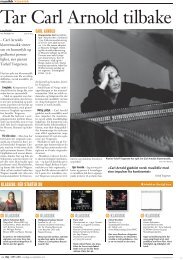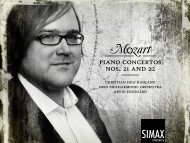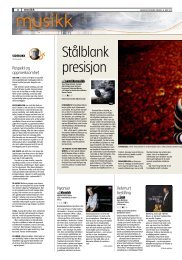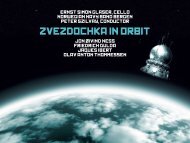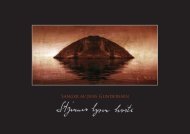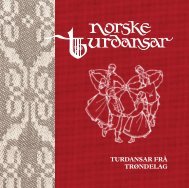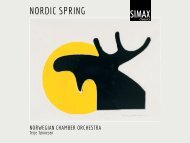Hjalmar Borgström
Hjalmar Borgström
Hjalmar Borgström
You also want an ePaper? Increase the reach of your titles
YUMPU automatically turns print PDFs into web optimized ePapers that Google loves.
possible to ascertain this work had not been performed in Norway prior to being recorded<br />
for the present CD.<br />
Jesus i Gethsemane and De dødes natt belong to a group of four symphonic poems which<br />
Borgstrøm composed during an intense, creative period between 1903 and 1905. The first<br />
of the four works was Hamlet for piano and orchestra, opus 13 (1903), the second Gethsemane,<br />
the third a symphonic prelude to Ibsen’s play John Gabriel Borkman, opus 15 (1905), and<br />
the fourth De dødes natt. Borgstrøm’s fifth and largest symphonic poem was Tanken (The<br />
Thought), opus 26, a large scale work in five movements which received its first performance<br />
in 1917, and was for many years considered to be one of the most important works in the<br />
history of Norwegian music. While Hamlet is based on Shakespeare and Borkman on Ibsen,<br />
the programme for Tanken was written by Borgstrøm himself.<br />
Borgstrøm wrote a programmatic text for Jesus i Gethsemane (1904) based on selected<br />
passages from the New Testament. The theme of the work focuses on the agony of Jesus<br />
the night before his crucifixion, resting in the Garden of Gethsemane with his disciples.<br />
Borgstrøm’s text is in German, and contains elements from all four gospels: Matthew 26:36–<br />
50, Mark 14:32–46, Luke 22:39–54 and John 18:1–12.<br />
Borgstrøm has eliminated many elements of “external” action from the biblical narrative,<br />
such as the scene where the disciples sleep instead of keeping watch with Jesus, or the scene<br />
in which Peter cuts off the ear of one of the soldiers who is then healed by Jesus. Instead,<br />
Borgstrøm concentrates on elements with a stronger spiritual or existential importance.<br />
The human fear and agony of the Saviour is given emphasis, as is the image of his sweat<br />
dripping to the earth as blood. The angel’s reply is placed further along in the musical narrative<br />
so that it follows the most pained outbreaks of anguish. The musical contrast is abrupt<br />
when Judas and the soldiers appear – to a deliberately banal march in the ‘cheap’ key of C<br />
11




